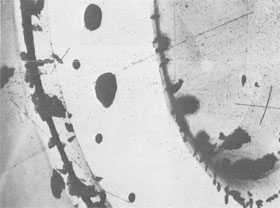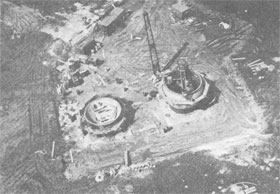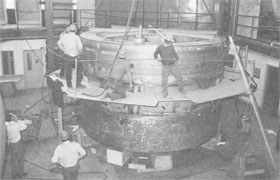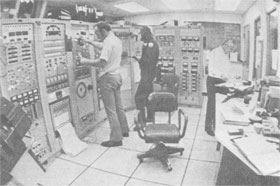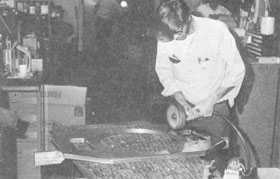NAL 15-foot Bubble Chamber Commissioned
The largest liquid hydrogen bubble chamber in the world was successfully operated for the first time at 5:15 p.m., Saturday, September 29, at the National Accelerator Laboratory. Tracks of particles using the NAL Main Accelerator were photographed as they traveled through the liquid hydrogen of the NAL 15-Foot Chamber. The new Chamber is located at the end of the NAL Neutrino Experimental Line.
The event marked the successful completion of three years of effort by one of the Laboratory's most dedicated teams. The highly-skilled group had worked round the clock for several days to fill the Chamber with liquid hydrogen. As the Chamber slowly filled, it was possible to look down, with the aid of a periscope, into the pool of colorless, very cold liquid, boiling near absolute zero temperature (-423° F).
In operation, the Bubble Chamber is somewhat analogous to an ordinary gasoline engine. A gigantic piston six feet across keeps the liquid hydrogen under pressure. At a signal from the Control Room, the piston drops more than four inches in about 60/1000ths of a second, lowering the pressure on the Chamber and expanding the liquid. The noise of the expansion reverberates through the building housing the Chamber, like a powerful rendition of the anvil chorus. The effect of the expansion is similar to shaking a soft drink; bubbles appear in many places, but they also make the paths of the particles which have passed through the Chamber visible.
Expansions were begun very carefully when the Chamber was brought into operation Saturday. At first, piston motions of only a small fraction of an inch were used. The system was watched carefully for any small motions that might indicate a misalignment. Gradually, as confidence built in the system, the piston stroke was increased. Right at the predicted stroke length, particle tracks became visible in the liquid, thereby signaling the successful commissioning of the NAL 15-Foot Bubble Chamber.
The Bubble Chamber Group has been led by Dr. William Fowler, one of the leading bubble chamber authorities in the world. Prior to joining the staff at NAL, Dr. Fowler had been a central figure in the very successful bubble chamber team at Brookhaven National Laboratory. Also playing a key role in the design and construction of the NAL Chamber have been scientists R. Huson, H. Kautsky, G. Mulholland, and W. Smart. They brought together at NAL an outstanding team of technicians and scientists, many with years of bubble chamber experience, for the complex and painstaking assembly and testing of the 15 Foot chamber.
The Chamber and How It Grew...
A crew of 27 employees will be responsible for operation of the Chamber. They include engineers F. Bellinger, D. Curtice, and J.B. Stoffel; engineering aides and technical specialists, A. Newman, W. Noe, C.B. Pallaver, and P. Thorkelsen. Technicians in this phase of 15-Foot operation are: R. Ahlman, G. Athanasiou, E. Beck, A. Coleman, J. Colvin, R. Davis, M. Diveley, R. Ferry, J. Foglesong G. Gadow, S. Johnston, J. Kilmer, C. McNeal, C. Pitts, G. Simon, R. Stoever, R. Thompson, S. Tonkin, J. White, and J. Woodworth.
Another crew will be responsible for research and development. This group includes engineers H.K. Feng, K. Kula, and M.W. Morgan. J.W. Thompson is technical specialist for this phase; C. Mangene and L. Robinson, technicians; designers are L. Mapalo, A. Skraboly, and H. Stapay.
The 15-Foot Chamber is greatly aided by an office staff headed by E. Renaud, and including D. Augustine, N. Johnson, and M. Richardson.
Also deeply involved in the Bubble Chamber effort has been the NAL Machine Shop. L. Chipless and Bob Jackson contributed to the final stretch effort. J. Ramus and S. Alexander of the Machine Shop are now permanently stationed in the Assembly Building of the Bubble Chamber Area.
Bubble chambers were first invented by Donald Glaser of the University of Michigan in 1952. The bubble chamber method, with its accompanying photographs allows detailed, careful analysis of the events which occur when sub-nuclear particles interact. Glaser, now primarily interested in biophysics, was awarded the Nobel Prize in 1960 for his invention. Much of the present form of bubble chambers was developed by the Lawrence Radiation Laboratory at the University of California for which Professor Luis Alvarez was awarded the Nobel Prize in 1968.
Over the years, bubble chambers have grown enormously in size and effectiveness. Roughly half of the discoveries in sub-nuclear physics have come from bubble chambers. The discovery of the omega minus particle in a bubble chamber at the Brookhaven National Laboratory chamber was a particularly famous example. The omega minus particle completed a "missing link" in the sub-nuclear zoo, and allowed confirmation of the present day particle classification scheme.
University physics departments have found research with bubble chamber photographs to be particularly useful to them because the analysis of the photos could proceed as time permitted on equipment that was readily available at university laboratories. At NAL, study of both the 15-Foot and the 30-Inch Bubble Chamber film is aided by the Film Analysis Facility presently located at 34 Shabbona.
The 15-Foot Bubble Chamber Group reached a major milestone on October 26, 1972 when it successfully tested the 150-ton circular superconducting magnet which surrounds the Chamber. The magnet, which produces a magnetic field of 30 kilogauss, was a significant development in itself, a joint project between NAL staff and a group from the Argonne National Laboratory. The magnet was not operated as part of last Saturday's test. The expansion system was also a joint project between NAL staff and a group from the Stanford Linear Accelerator Center, Palo Alto, California. The collaboration and cooperation between the national laboratories contributed significantly to the success of the NAL 15-Foot Bubble Chamber. This cooperation will certainly prove valuable in future projects.
The next phase of reaching routine operation with the 15-Foot Chamber will be to add the operation of the magnet to the sequence. The magnet serves to bend the particles as they come racing through the hydrogen; they can then be more clearly distinguished, identified, and studied.
The successful expansion of the Bubble Chamber followed by less than a week the first pulsing of the NAL neutrino horn on Saturday, September 22 at 9:30 p.m. Within minutes, the system was operating at the full design value of 150,000 amperes. The system operated over the weekend with only minor interruptions accumulating 12,000 pulses by Monday morning. The horn gives the Neutrino Line greatly enlarged focusing power, allowing a well defined beam of neutrinos to continue down the Neutrino Line. The first tests included operating the full pulsed power supply, the current polarity reversal switch, the complicated three-plate current transmission line, and the neutrino horn itself.
The success of the first trial attests to the quality of the design and workmanship carried out by another "NAL Team" as well as to their tenacity in meeting difficult construction deadlines. Frank Nezrick headed the Horn project. Russ Winje, with the help of the Neutrino Section technicians, contributed a pulsed power supply of great flexibility and versatility. Glen Lee, with the help of Main Accelerator draftsmen, supervised the design of the mechanical elements of the horn system. Luther Hardy and the Hi-Rise Machine Shop solved the unusual construction problems of the Horn system with the interesting twisted bars that have been seen in the Hi-Rise for the last weeks. Jack Lindberg, John Simon and the target handling group mounted the horn components and produced an operational horn trainload. Frank Krzich and his colleagues produced a pulsed water cooling system which is but a fraction of the size of comparable systems at other laboratories.





